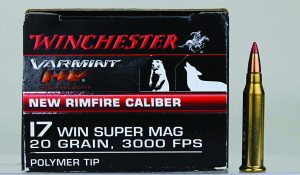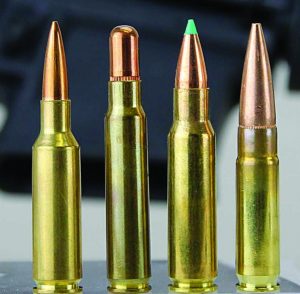By Art Merrill | Contributing Editor
Probably the most prolific years for the invention of wildcat cartridges spanned the period from about 1910 through the Great Depression, and again following WWII and into the 1960s. Open any gun magazine from those periods and it will be the rare one indeed that doesn’t include mention of a wildcat, even if only in the advertising.
For bullet makers and experimenters Vernon and Raymond Speer, wildcatting deserved focused attention, which they gave it in 1956 with publication of the Speer Products Company’s Wildcat Rifle Loads appearing only two years after Speer published its very first reloading manual. In it, they said of wildcat cartridges, “In the last ten years the things have multiplied in a manner that would shame the most prolific pair of rabbits that ever lived.”
New niches

The pinnacle of the factory .17 rimfires, the 17 WSM delivers a scorching 3,000fps. Wildcatting rimfires to this degree is beyond the average handloader.
So, where have the rabbits gone? Why has wildcatting fallen off in popularity compared to the past? The major driving influence in wildcatting was the perceived need of a better cartridge to fill a specific niche, such as shooting woodchucks or rhinos or one-hole groups. These niches are long filled now, many of them by former wildcats that are today factory offerings, and we face our old elementary school math question of how many times we can divide a ruler as new cartridges attempt to split hairs between existing cartridges. We appear to be at an historical point where manufacturers are creating new niches in order to create new cartridges, with only some success.
The intent of the Winchester Super Short Magnums, for example, was to shrink magnum performance into a short action rifle, and they succeed at that. But sales of so-chambered rifles don’t appear to be particularly brisk, and in the past two years only one hunter has walked into our local gun shop to ask for a box of WSSM cartridges in any caliber—and then balked at the price, so the box (yes, the only box of WSSM cartridges) is still there on the shelf. The WSSM story is a separate adventure tale of overbore and chrome.
Interestingly, some newer specialty cartridges exist only in riding the coattails of the AR-15/M-16, and that’s pretty niche-y. In 2017 the new 22 Nosler succeeded in reaching that company’s goal of creating the most powerful .22 caliber cartridge for the AR-15 platform; it was a brief pinnacle, as this year Federal’s new 224 Valkyrie claims that prize. The 6.8 SPC and 458 SOCOM both came about to make the M-16 a better man-stopper. The 25 Sharps holds a said caliber bullet of RN design and touts itself as a pig-stopper, and 2018’s debut of a rimless 45-70, the 45-70 Auto, turns the AR-10 into, presumptively, a semiauto buffalo stopper. The 300 Blackout, as a subsonic cartridge, goes even nichier (is that a word?) in tying itself to a suppressed AR-15. Sure, you could shoot any of these cartridges in a bolt action or single-shot rifle, but cartridges that outperform them in those platforms already exist and, again, their whole raison d’etre is solely the AR-15/M-16 rifle.
Wild ‘n 17
About two decades ago manufacturers were quietly exploring territory mostly closed to the wildcatting general public: rimfires. Specifically, .17 caliber rimfires! Like a flash flood in a desert wash, the .17 rimfires began with a trickle that has become a torrent. Hornady introduced the 17HMR (Hornady Magnum Rimfire), a .17 caliber bullet on a necked-down 22 WMR case, in 2002. With a 17-gr. bullet weight about half that of a 22LR bullet, muzzle velocity is doubled at about 2,550fps. Two years later Hornady brought out a 22LR necked down to .17, the 17 Mach II or 17HM2, launching the same bullet at 2,100fps, to fit in 22LR length actions. In 2013 Winchester jumped on the 17 bandwagon to outdo the Hornady offering with the 17 Winchester Super Magnum (17WSM); their Varmint-X loading breaks the magical 3,000fps barrier with a 15-gr. polymer tip bullet. The 17WSM’s parent case is unique in being, not wildcatted from another cartridge per se, but from the .27 caliber nail gun blank.

Cartridges that are essentially homeless but for the AR-15 include: (L-R) 244 Valkyrie, 25 Sharps, 6.8 SPC and 300 Blackout.
These .17s have been accompanied by bolt action rifles, and they are only belatedly and falteringly finding homes in semi-automatic firearms. Semi-autos for rimfire cartridges universally work on the blowback principle wherein to cycle the action the energy of the fired cartridge works against the mass of an unlocked bolt and the tension of its return spring. It’s a balancing act against the pressure generated by the cartridge, and the .17s produce significantly more pressure than the 22LR, so you can’t safely convert a semi-auto .22 to .17 by simply hanging a .17 caliber barrel on it.
The advent of the .17 rimfires coincided with, first, a years-long drought of 22LR cartridges, and then a whopping 50 percent increase in the retail cost of 22LR ammo now that it’s available again. It seems extremely unlikely that the two events are completely unrelated, though conspiracy theories may be unwarranted. Regardless of the reasons, perhaps the largest impact of the .17 rimfires is that they have ended a 150-year-long paradigm of shooters enjoying rimfire cartridges as inexpensive plinking rounds. At about 32¢ per round, the .17s cost as much as some centerfire ammunition. And whereas a 50-round box of 22LR cost about 6¢ per round in 2002, today most run about 10¢ each for common fodder. OK, a dime isn’t prohibitively expensive, but with the rimfire .17s among us, we can no longer automatically equate, “rimfire” with, “So cheap that blowing through a brick of 500 rounds is almost free.” The telling evidence is that manufacturers do not package .17 rimfires in bricks, which, at 32¢ per round, would cost $160 per brick—not a cheap Saturday afternoon by any measure.
What next?
Wildcatting of rimfire cartridges is extremely limited, given the nature of the priming, consisting mostly of “hollow pointing” RN bullets with a (duh) hollow pointing tool, or of trimming bullet meplats (noses) to give them greater consistency for competition. A very few handloaders experiment with pulling 22 WMR bullets and/or powder and utilizing the primed cases for their own bullet/powder recipes. This practice pushes the safety envelope, as pulling bullets from live rimfire rounds can be a dodgy thing and there is no laboratory tested reloading data out there. And we can guess that if such “Mexican match” ammo made real improvements over factory rimfire loadings, it would be a more common practice, anyway.
Is wildcatting dead? No! A great many handloaders enjoy the pursuit, some for the educational value, some for the nostalgia, some perhaps hoping that they’ll discover something that others have missed. It does appear, however, that the days of individual wildcatters—and factories, for that matter—inventing genuinely and widely useful new cartridges that significantly outperform what we already have, that can do what no other extant cartridge can do, may be over.
Though we can theoretically divide a ruler an infinite number of times, the effort doesn’t necessarily result in anything practical.



